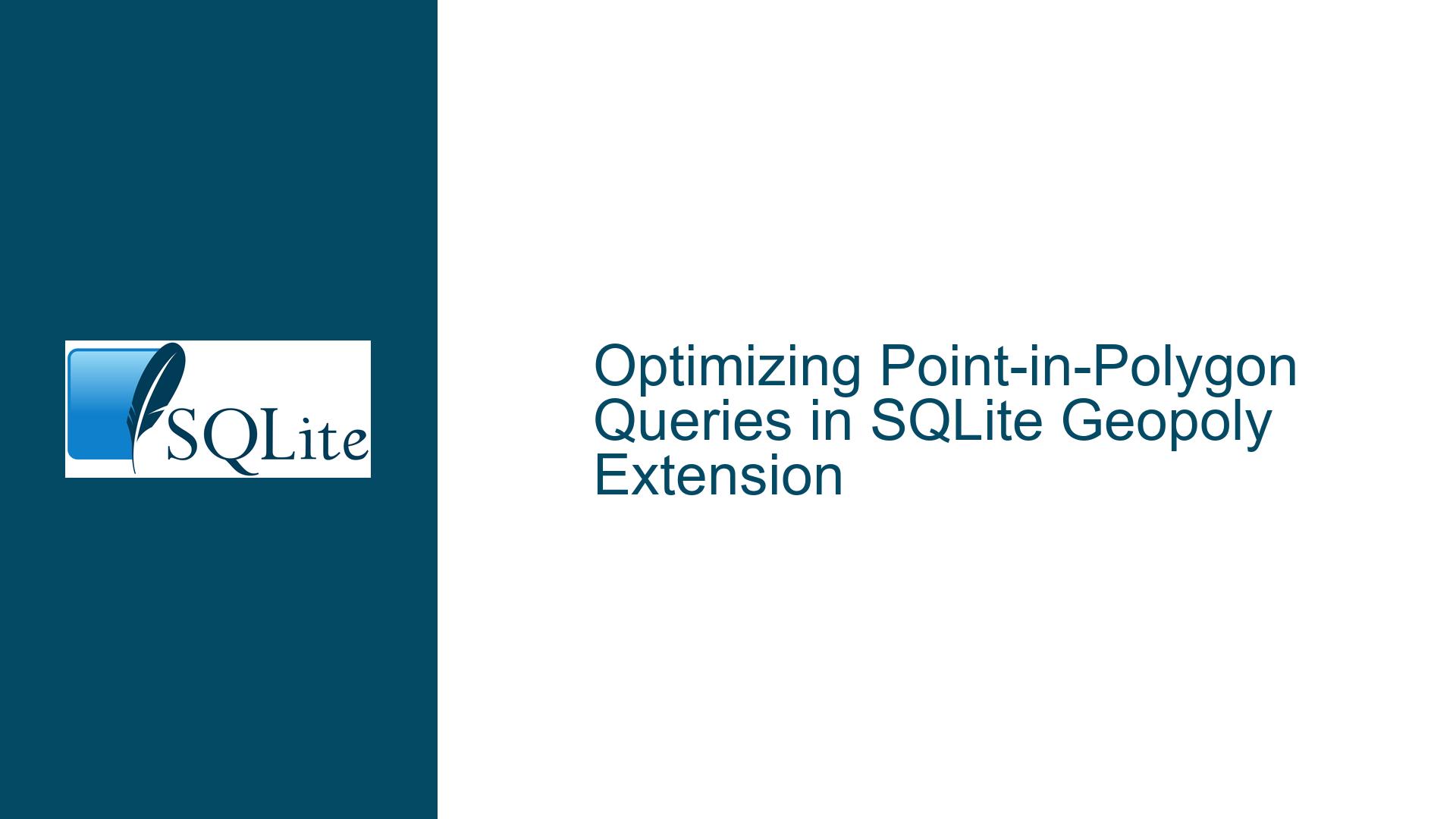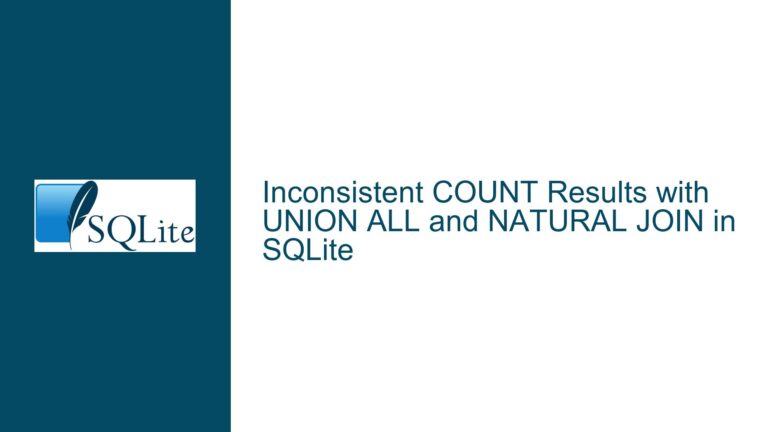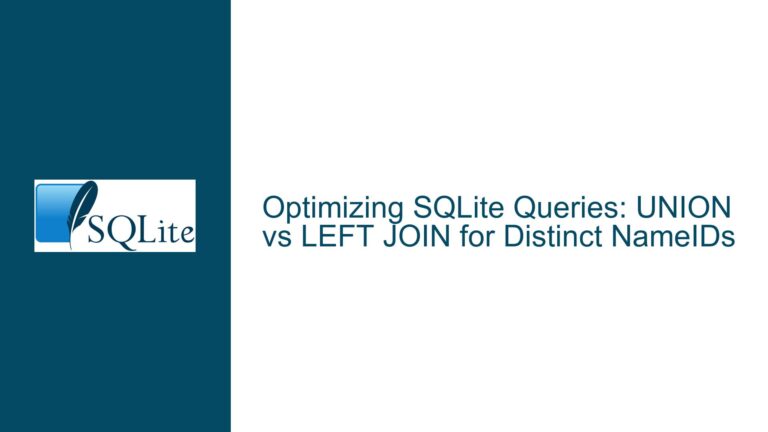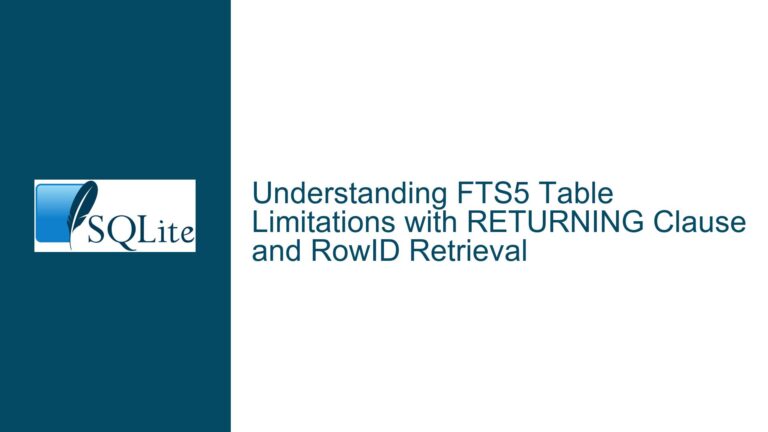Optimizing Point-in-Polygon Queries in SQLite Geopoly Extension
Understanding Full-Table Scans During Geospatial Point Containment Checks
The core challenge revolves around efficiently determining which polygon from a geospatial table contains a given point using SQLite’s Geopoly extension. The user observes that a query leveraging geopoly_contains_point() triggers a full-table scan of the polygon table despite the presence of a single point to test. This results in unacceptable performance, especially with large polygon datasets.
Key Observations from the Query Plan
The query plan reveals two critical bottlenecks:
- Full Scan of the Virtual Geopoly Table: The
ecoregionsGeopolyvirtual table (backed by Geopoly’s R*Tree index) is scanned exhaustively (INDEX 4:fullscan), bypassing any spatial indexing optimizations. - Redundant Scan of the CTE: The
geocommon table expression (CTE), which contains exactly one point due toLIMIT 1, is scanned linearly despite its trivial size.
The Geopoly extension optimizes for specific spatial predicates: geopoly_contains() and geopoly_within(), which compare two polygons. These functions leverage the R*Tree index to efficiently narrow down candidate polygons. However, geopoly_contains_point(), which checks if a single coordinate pair lies within a polygon, does not trigger index utilization. This function forces SQLite to evaluate every polygon in the table against the point, resulting in an O(N) runtime proportional to the polygon count.
Root Causes of Index Bypass and Query Hangs
Three interrelated factors contribute to the performance degradation:
1. Geopoly’s Function-Specific Indexing Limitations
Geopoly’s RTree index is activated only when spatial relationships between two polygons are queried via geopoly_contains() or geopoly_within(). These functions allow the query planner to exploit the hierarchical structure of the RTree to eliminate non-overlapping regions early.
In contrast, geopoly_contains_point() operates on a point and a polygon. Points lack the dimensional breadth required to participate in R*Tree range comparisons. Without a bounding box or auxiliary spatial index tailored for points, the engine must resort to brute-force evaluation.
2. Misalignment Between CTE Isolation and Join Logic
The geo CTE is materialized before joining with ecoregionsGeopoly. While the CTE itself executes swiftly (400ms for a random valid point), the subsequent join operation does not benefit from indexed lookups. Each polygon in ecoregionsGeopoly is checked against the point using geopoly_contains_point(), which lacks index support.
This forces a nested loop join:
- Outer Loop: Scan all polygons (full table scan).
- Inner Loop: For each polygon, check containment against the CTE’s point (constant time per polygon, but O(N) overall).
For tables with millions of polygons, this quickly becomes computationally prohibitive.
3. Virtual Table Constraints and Planner Heuristics
Geopoly virtual tables do not expose traditional columnar indexes. Instead, their indexing is tightly coupled with the geopoly_contains()/geopoly_within() functions. The query planner lacks statistics or cost models to infer that a single-point lookup could benefit from spatial pruning. Consequently, it defaults to the safest (but least efficient) execution strategy: full scans.
Step-by-Step Solutions for Accelerated Point-in-Polygon Queries
1. Bounding Box Filtering with Geopoly_Within()
To leverage the R*Tree index, convert the point into a minimal bounding polygon (e.g., a 1m x 1m square) and use geopoly_within() for an initial coarse filter:
WITH geo (id, longitude, latitude, search_area) AS (
SELECT
id,
longitude,
latitude,
geopoly_regular(
longitude, -- Center X
latitude, -- Center Y
0.00001, -- Width (~1m at equator)
0.00001, -- Height
4 -- Rectangle (4 sides)
) AS search_area
FROM materialCitations
WHERE validGeo = 1
ORDER BY random()
LIMIT 1
)
SELECT
ecoregions_id,
biomes_id,
realms_id
FROM ecoregionsGeopoly
JOIN geo ON
geopoly_within(_shape, geo.search_area) AND -- Index-accelerated coarse filter
geopoly_contains_point(_shape, geo.longitude, geo.latitude); -- Precise check
Breakdown:
- The CTE generates a tiny rectangular polygon (
search_area) around the random point. geopoly_within(_shape, geo.search_area)exploits the R*Tree index to find polygons intersecting the bounding box.- The refined
geopoly_contains_point()check operates on a drastically reduced subset of polygons.
Adjusting Bounding Box Size:
- The
0.00001delta ingeopoly_regular()approximates a 1m buffer at the equator. Adjust this based on coordinate precision and polygon density. Larger buffers increase false positives but ensure the true containing polygon is included.
2. Parameterized Queries for Batch Processing
For repeated point-in-polygon tests (e.g., batch geocoding), precompute bounding boxes and parameterize the query:
-- Precompute bounding box for a specific point
SELECT geopoly_regular(?, ?, 0.00001, 0.00001, 4) AS search_area;
-- Use the precomputed shape in a parameterized query
SELECT
ecoregions_id,
biomes_id,
realms_id
FROM ecoregionsGeopoly
WHERE
geopoly_within(_shape, :search_area) AND
geopoly_contains_point(_shape, :longitude, :latitude);
Benefits:
- Separating bounding box generation from the main query allows reuse across multiple points.
- Parameter binding avoids redundant CTE materialization.
3. Geopoly Indexing Deep Dive and Custom Functions
For advanced use cases, consider extending Geopoly’s functionality with custom SQL functions or virtual table enhancements:
A. Proxy Polygon for Point Indexing:
Map points to degenerate polygons (e.g., a single-point "polygon") and use geopoly_within():
-- Add a 'point_polygon' column to materialCitations
UPDATE materialCitations
SET point_polygon = geopoly_regular(longitude, latitude, 0, 0, 4);
-- Create a Geopoly virtual table for points
CREATE VIRTUAL TABLE IF NOT EXISTS geo_points USING geopoly(point_polygon);
-- Query using polygon-polygon containment
SELECT
ecoregions_id
FROM ecoregionsGeopoly
JOIN geo_points ON
geopoly_contains(_shape, geo_points.point_polygon);
Caveats:
- Degenerate polygons may not be handled optimally by Geopoly.
- Increases storage overhead and write-time computation.
B. Custom R*Tree Integration:
For ultimate performance, implement a custom SQLite extension that integrates a point-optimized R*Tree. This requires C programming and familiarity with SQLite’s virtual table API.
4. Query Plan Analysis and Forcing Index Hints
While SQLite generally discourages index hints, in extreme cases, forcing a materialized CTE can alter the planner’s behavior:
WITH geo AS MATERIALIZED (
SELECT ... -- Same as original CTE
)
SELECT ... -- Join with geopoly_contains_point
Effect:
MATERIALIZEDensures the CTE is fully evaluated before joining, preventing predicate pushdown that might interfere with Geopoly’s index eligibility.
5. Geopoly Configuration and Data Modeling Tweaks
Revisit the schema design and Geopoly parameters to align with point-in-polygon workflows:
A. Polygon Pre-Filtering with Bounding Box Columns:
Add explicit bounding box columns to ecoregionsGeopoly and maintain them via triggers:
ALTER TABLE ecoregionsGeopoly ADD COLUMN min_x REAL;
ALTER TABLE ecoregionsGeopoly ADD COLUMN max_x REAL;
ALTER TABLE ecoregionsGeopoly ADD COLUMN min_y REAL;
ALTER TABLE ecoregionsGeopoly ADD COLUMN max_y REAL;
-- Update triggers to set bbox on INSERT/UPDATE
CREATE TRIGGER ecoregionsGeopoly_bbox AFTER INSERT ON ecoregionsGeopoly
BEGIN
UPDATE ecoregionsGeopoly
SET
min_x = geopoly_bbox(_shape)->>'xmin',
max_x = geopoly_bbox(_shape)->>'xmax',
min_y = geopoly_bbox(_shape)->>'ymin',
max_y = geopoly_bbox(_shape)->>'ymax'
WHERE rowid = NEW.rowid;
END;
Query with Bounding Box Pre-Check:
SELECT ecoregions_id
FROM ecoregionsGeopoly
JOIN geo ON
geo.longitude BETWEEN min_x AND max_x AND
geo.latitude BETWEEN min_y AND max_y AND
geopoly_contains_point(_shape, geo.longitude, geo.latitude);
Benefits:
- The bounding box check uses standard B-tree indexes (if created) for initial filtering.
- Reduces the number of polygons subjected to the expensive
geopoly_contains_point().
B. Cluster Polygons by Spatial Proximity:
Use SQLite’s CLUSTER command (via the sqlean extension) to physically order polygons by their bounding box centroids. This improves locality of reference during full scans, marginally accelerating brute-force checks.
6. Alternative Approaches and Ecosystem Tools
When Geopoly’s limitations prove insurmountable, evaluate complementary tools:
A. Spatialite Integration:
Use Spatialite’s comprehensive GIS functions via SQLite loadable extensions. Spatialite supports true point-in-polygon indexing and advanced spatial joins.
B. Hybrid SQLite-PostGIS Workflow:
For heavy geospatial processing, export SQLite data to PostgreSQL/PostGIS, perform the point-in-polygon query there, and re-import results.
C. Client-Side Processing:
Retrieve all polygons overlapping a point’s bounding box via geopoly_within(), then perform exact containment checks in application code using libraries like shapely (Python) or turf.js (JavaScript).
7. Benchmarking and Profiling Strategies
Isolate performance bottlenecks through systematic testing:
A. Explain Query Plan Analysis:
Run EXPLAIN QUERY PLAN before and after optimizations to verify index usage.
B. Polygon Subsampling:
Test queries on a 1% subset of polygons to estimate full-table scan time:
SELECT ecoregions_id
FROM ecoregionsGeopoly
WHERE rowid IN (SELECT rowid FROM ecoregionsGeopoly ORDER BY random() LIMIT ABS((SELECT COUNT(*) FROM ecoregionsGeopoly)/100))
AND geopoly_contains_point(_shape, :x, :y);
C. Geopoly Function Timing:
Measure raw geopoly_contains_point() performance by benchmarking against a single polygon:
SELECT COUNT(*)
FROM ecoregionsGeopoly
WHERE geopoly_contains_point(_shape, :x, :y);
-- Compare with:
SELECT COUNT(*)
FROM ecoregionsGeopoly
WHERE geopoly_within(_shape, :search_area);
This guide systematically addresses the geospatial query performance issues inherent to SQLite’s Geopoly extension, offering both immediate workarounds and long-term architectural recommendations. By combining bounding box pre-filtering, query plan manipulation, and alternative tooling, developers can achieve sub-second point-in-polygon lookups even on large datasets.






